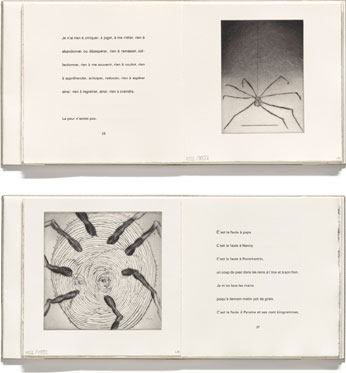Illustrated Books
Louise Bourgeois admired illustrated books as objects, often slowly turning their pages to relish the artistic contributions, the typography, and the overall design. She was also a reader—of literary works, psychology, history, and mythology; her many bouts of insomnia were often mitigated with reading. A fascination with words made the dictionary and thesaurus Bourgeois’s trusted friends, while her fluency in French and English added further dimensions of meaning to explore. Writing was yet another tool. She made copious notes, often with poetic cadences and probing metaphors. These can be found in her diaries, on the backs of drawings, and on random sheets she happened to have at hand.
The most ambitious work of Bourgeois’s early years, before she turned definitively to sculpture, was the small illustrated book containing her own parables, titled He Disappeared into Complete Silence. It remains a touchstone of her oeuvre, setting out themes she pursued for the rest of her life. Later, from the 1980s on, when Bourgeois was well known, she was sought out by publishers and several important illustrated volumes resulted. She also decided to create books on her own, particularly with pages fashioned from old fabric belongings. These illustrated book projects—approximately a dozen in all—provided an artistic means to accommodate the complex narratives fundamental to Bourgeois’s vision. It is fitting that among her last works, in 2010, was To Whom It May Concern, a hefty book/object, created in collaboration with the poet Gary Indiana, comprising text and illustrations printed on fabric pages.

Untitled, plates 5 and 6 of 9, from the illustrated book, Ode à ma mère. 1995. Drypoint
“Words were all I had at
hand
apart from the five senses.”